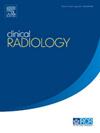The value of machine learning based on magnetic resonance imaging (MRI) and biopsy whole-slide image to predict pathological complete response to breast cancer after neoadjuvant chemotherapy: a two-centre study
IF 2.1
3区 医学
Q2 RADIOLOGY, NUCLEAR MEDICINE & MEDICAL IMAGING
引用次数: 0
Abstract
AIM
To develop and validate a combined model based on magnetic resonance imaging (MRI), and whole-slide imaging (WSI) to predict pathological complete response (pCR) after neoadjuvant chemotherapy (NAC) in breast cancer.
MATERIALS AND METHODS
We retrospectively enrolled 331 patients from two institutions, who pathologically confirmed to have invasive breast cancer and underwent NAC. Radiological features from original lesions on MRI and clinicopathological data were analysed using univariate and multivariate logistic analyses, which established the clinical model. Radiomics features were extracted based on the region of interest by manually delineating the primary focus on the sequences of the first phase of enhanced MRI, diffusion weighted imaging (DWI), and apparent diffusion coefficient (ADC) mapping. The radiomics prediction model was established using the Pearson product-moment correlation coefficient, least absolute shrinkage and selection operator (LASSO) regression analysis. A deep learning pathological model (DLPM) was established from WSIs of patients used AlexNet. The combined model was developed based on clinicopathological features, radiomics features, and pathomics deep learning features, and presented as a nomogram.
RESULTS
Five clinical and three deep learning features were screened and combined with the Rad-score to establish a combined model. The results showed that the nomogram had good predictive efficiency, with area under the curve (AUC) values of 0.95, 0.84, and 0.83 in the training, test, and external validation cohorts, respectively. The DeLong’s test showed that the difference in AUC values between the combined model and the other single models was statistically significant (p < 0.05).
CONCLUSION
A combined nomogram based on MRI and biopsy WSI can predict pCR to NAC in patients with breast cancer.
基于磁共振成像(MRI)和活检全切片图像的机器学习预测乳腺癌新辅助化疗后病理完全缓解的价值:一项双中心研究
目的建立并验证基于磁共振成像(MRI)和全切片成像(WSI)的联合模型,预测乳腺癌新辅助化疗(NAC)后病理完全缓解(pCR)。材料与方法我们回顾性地纳入了来自两个机构的331例经病理证实为浸润性乳腺癌并行NAC的患者。通过单因素和多因素logistic分析,对原始病变的MRI影像学特征和临床病理资料进行分析,建立临床模型。放射组学特征是基于感兴趣的区域提取的,通过手动描绘增强MRI第一阶段序列的主要焦点,扩散加权成像(DWI)和表观扩散系数(ADC)映射。采用Pearson积矩相关系数、最小绝对收缩和选择算子(LASSO)回归分析建立放射组学预测模型。通过使用AlexNet的患者wsi建立深度学习病理模型(DLPM)。该组合模型基于临床病理特征、放射组学特征和病理深度学习特征建立,并以nomogram形式呈现。结果筛选5个临床特征和3个深度学习特征,并结合rad评分建立联合模型。结果表明,该模型具有较好的预测效果,训练、测试和外部验证组的曲线下面积(AUC)分别为0.95、0.84和0.83。DeLong’s检验表明,组合模型与其他单一模型的AUC值差异有统计学意义(p <;0.05)。结论基于MRI和活检WSI的联合nomogram可预测乳腺癌患者的pCR - NAC。
本文章由计算机程序翻译,如有差异,请以英文原文为准。
求助全文
约1分钟内获得全文
求助全文
来源期刊

Clinical radiology
医学-核医学
CiteScore
4.70
自引率
3.80%
发文量
528
审稿时长
76 days
期刊介绍:
Clinical Radiology is published by Elsevier on behalf of The Royal College of Radiologists. Clinical Radiology is an International Journal bringing you original research, editorials and review articles on all aspects of diagnostic imaging, including:
• Computed tomography
• Magnetic resonance imaging
• Ultrasonography
• Digital radiology
• Interventional radiology
• Radiography
• Nuclear medicine
Papers on radiological protection, quality assurance, audit in radiology and matters relating to radiological training and education are also included. In addition, each issue contains correspondence, book reviews and notices of forthcoming events.
 求助内容:
求助内容: 应助结果提醒方式:
应助结果提醒方式:


